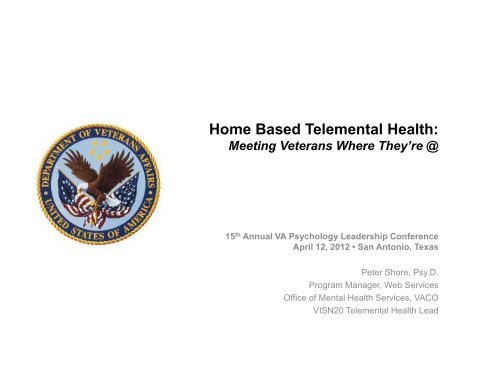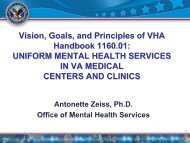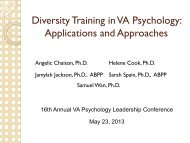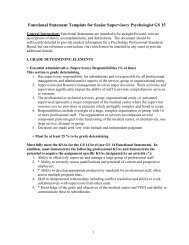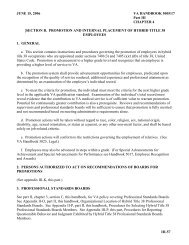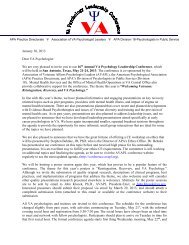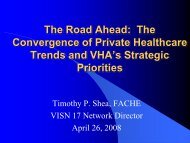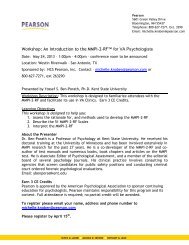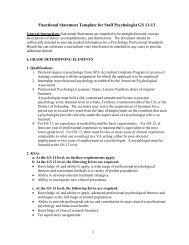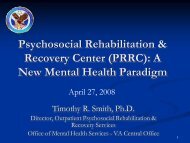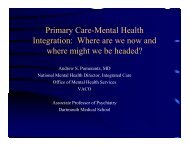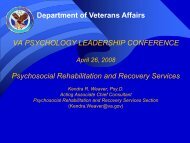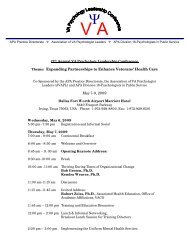Home Based Telemental Health.pdf - VA Psychology Leadership ...
Home Based Telemental Health.pdf - VA Psychology Leadership ...
Home Based Telemental Health.pdf - VA Psychology Leadership ...
You also want an ePaper? Increase the reach of your titles
YUMPU automatically turns print PDFs into web optimized ePapers that Google loves.
<strong>Home</strong> <strong>Based</strong> <strong>Telemental</strong> <strong>Health</strong>:<br />
Meeting Veterans Where They’re @<br />
15 th Annual <strong>VA</strong> <strong>Psychology</strong> <strong>Leadership</strong> Conference<br />
April 12, 2012 • San Antonio, Texas<br />
Peter Shore, Psy.D.<br />
Program Manager, Web Services<br />
Office of Mental <strong>Health</strong> Services, <strong>VA</strong>CO<br />
VISN20 <strong>Telemental</strong> <strong>Health</strong> Lead
Secretary Eric K. Shinseki<br />
"For all of you, as well, success lies in your willingness to<br />
collaborate across the broad landscape of mental health care. How<br />
are we doing at creating our "pit crews" within each medical care<br />
facility? And you are not limited by the walls of the medical center.<br />
How are we doing at "pit crewing" our Medical Centers with our Vet<br />
Centers, and mobile clinics with our rural mental health initiatives<br />
and home-based telemental health care?”<br />
VHA's Mental <strong>Health</strong> Conference<br />
Baltimore, Maryland<br />
August 23, 2011
What is HBTMH?
What is HBTMH?<br />
• Computer-to-computer or video teleconference technology-to-<br />
personal support computer utilizing i an external or internal webcam<br />
for viewing on patient side with Federal Information Processing<br />
Standards (FIPS) secure and encrypted software technology.<br />
• Remote Mobile Access Clinics (R-MAC). Video teleconference<br />
technology-to-mobile device (i.e. Tablet, Smart Phone, Netbook that<br />
has two-way camera capability). R-MAC utilizies Federal Information<br />
Processing Standards (FIPS) secure and encrypted software<br />
technology.<br />
• Currently: Cisco Teleprescence (aka MOVI) becoming Jabber<br />
• Unsupervised clinical settings.
Purpose<br />
• Meet Veterans where they're at (literally).<br />
• Create a patient-centric / provider-empowered<br />
program aimed at serving the mental health needs of<br />
Veterans whose access to care is restricted t by<br />
geography, limited resources or who are home bound<br />
due to psychiatric and/medical conditions.<br />
• Treatment provided in the homes, care facilities and/or<br />
remote location where ever the Veteran is situated.<br />
• Have included: CPT for PTSD, Behavioral Activation for<br />
Depression, ACT for Chronic Pain, Anger Management,<br />
Cognitive Remediation (CogSmart), Chronic Disease<br />
Management, Medication Management
Current State<br />
• T21 initiative identifies IP Video into the <strong>Home</strong> as an OTS<br />
Pilot Program which utilizes Cisco Teleprescense with a<br />
structured scheduling interface.<br />
• Only known other implemented HBTMH Pilot Program:<br />
– VISN 20 <strong>Home</strong> <strong>Based</strong> <strong>Telemental</strong> <strong>Health</strong> Pilot Program<br />
(launched February 2010).
VISN 20 <strong>Home</strong> <strong>Based</strong> <strong>Telemental</strong><br />
<strong>Health</strong> Pilot Program<br />
Meeting Veterans Where They’re @<br />
Since February 2010
Program Structure<br />
Key Features<br />
• Staffing: Clinical Champion/Provider, Telehealth Coordinator,<br />
Telehealth Clinical Technician, Peer Support Person – Technology<br />
(PSP-T)<br />
• Phase I: 1 provider, 10 patients, 60 encounters (no exposure<br />
based PTSD tx)<br />
• Phase II: 6 providers, 500 encounters<br />
• Phase III: Maintain 3 providers, no max encounters.<br />
• Patient Support Person (PSP): Each Veteran registers a Patient<br />
Patient Support Person (PSP): Each Veteran registers a Patient<br />
Support Person (PSP).
Program Structure<br />
Implementation<br />
• Standard Operating Procedure Manual (SOP)<br />
– Practice Guidelines become SOP-manual for program<br />
implementation, Veteran selection and clinical practice<br />
guidelines. (Shore, 2011)<br />
– VISN level approvals<br />
• Train the Trainer<br />
– Phase II Provider trains incoming Phase I Provider, etc. To date:<br />
38 providers have been trained.<br />
• ASH-25 – A Structured Guide for the Assessment of Suitability for<br />
<strong>Home</strong> <strong>Based</strong> <strong>Telemental</strong> <strong>Health</strong> (Shore, 2011)<br />
– Risk Management and Suitability Measure
Veteran Selection<br />
Remember: it’s a “Pilot Program”
Inclusion Criteria<br />
1. Referral for MH – access to care issues.<br />
2. Must have a computer / broadband access.<br />
3. Must have PCP/MH POC.<br />
4. Must be an enrolled Veteran.<br />
5. Must be able to enlist a PSP.<br />
6. Provider completed an ASH.<br />
7. Exclusionary criteria i ruled out.
Exclusion Criteria<br />
• Rejects telehealth in the informed consent<br />
process.<br />
• With immediate need for hospitalization.<br />
• Acutely violent or unstable Veterans with poor<br />
impulse control<br />
• Active suicidal or homicidal ideation<br />
• Severely decompensated
Exclusion Criteria<br />
• Dementia: confusion or mild cognitive i decline.<br />
• Requiring involuntary commitment in states<br />
which<br />
a) do not legally acknowledge telehealth evaluations for<br />
this purpose,<br />
b) states that require licensure in the state where<br />
Veteran is located if clinician in different state.<br />
• Without broadband access to DSL, cable, 3g<br />
or 4g internet connection<br />
• Without personal computer.
Exclusion Criteria<br />
i<br />
• Essential medical monitoring that is unavailable on site<br />
• Psychotic disorders d that t may be exacerbated by<br />
telemental health (e.g. ideas of reference regarding<br />
television)<br />
• Untreated Substance abuse/dependence (current<br />
and/or extensive history with elongated sobriety and<br />
relapse)<br />
• Significant sensory deficits
Risk & Safety Management<br />
(in 3 minutes or less)
• Licensing<br />
• Involuntary detainment / commitment<br />
• Liability<br />
• Best Practices<br />
• Consult with State Law<br />
• Pre-Session Procedures<br />
• Patient Support Person (PSP)<br />
• Imminent Risk
Don’t worry… it’s only<br />
Technology<br />
And it will change again.
• MOVI/Jabber is a Third Party Software.<br />
• Webcam is a Third Party Software.<br />
• MOVI installation ti and usernames (step-bystep)<br />
in SOP.<br />
• Connectivity issues.<br />
• Stability of network.<br />
• Common problems: DSL vs. Cable<br />
Modem vs. Satellite vs. Dial up vs. WIFI
VISN 20 HBTMH Pilot<br />
Data Sample
Phase I Overview<br />
– 1 provider: Peter Shore, Psy.D. (Clinical<br />
Psychologist)<br />
– 9 Veterans, 60 Encounters total (6 sessions via<br />
Telework)<br />
– No PTSD tx as primary treatment EBTs for<br />
Chronic Pain, Depression, Cognitive Strategies<br />
and Anger Management. Some general support,<br />
voc rehab counseling
Phase I<br />
(June – September 2010)<br />
• 9 Veterans, 60 encounters<br />
• 4,012 Total Miles saved<br />
• Approximately $11,394.09 in travel<br />
reimbursement saved<br />
• 99% show rate: 0 Veteran cancellations / 1<br />
Veteran reschedule edu e / 2 no shows<br />
s
Expected Benefits<br />
• Increased access to MH services /<br />
decreased barriers to treatment<br />
• Less Veteran stress associated with travel<br />
• Less potential for passing on sickness with<br />
clinic visits<br />
• Flexibility in scheduling<br />
• Lower cost per encounter (Provider clinic<br />
space, miles saved, travel reimbursement<br />
saved)<br />
• Inherent environmental benefits with<br />
reduced transportation requirements
Unexpected Benefits<br />
• Stigma a non-issue.<br />
• Less guarded, more vulnerable vs. traditional TMH<br />
• Identified excellent platform for treatment resistant<br />
history<br />
• Honored <strong>VA</strong> treatment resistant Veterans<br />
• Closer Veteran follow up<br />
• Increased frequency of visits = shorter length of<br />
treatment<br />
e t<br />
• Satisfaction Survey sample results suggest<br />
significantly higher levels than “traditional” TMH
Phase II Highlights<br />
g<br />
(September 2010-present)<br />
• March 2011: VISN <strong>Leadership</strong> approved VISN<br />
wide expansion:<br />
• Provider Pool expands via “Train The Trainer”:<br />
– 38 mental health providers and/or administrators have<br />
been trained.<br />
– 7 of the 8 VISN medical centers have at least 1<br />
provider.<br />
– Oregon, Washington, Alaska, Idaho.
Phase II<br />
• PTSD Tx in the home – 3 CPT cases<br />
completed.<br />
– “Our Veteran”: Pre Tx PCL=71, Session 6<br />
PCL=55, Post Tx PCL=38<br />
• Closer collaborations between prescriber<br />
and psychotherapist via “shared Veterans”<br />
• Peer Support Person– Technical (PSP-T)<br />
an HBTMH Beneficiary<br />
• Monthly HBTMH Consultation Call (open)
Random Sample (n=40)<br />
• Gender: 87.5% Male; Mean Age: 503 50.3<br />
• Era: OIF/OEF/OND: 30%; Vietnam: 40%<br />
• Total # of Encounters: 354 (Range: 1-29; Mean: 8.7)<br />
• Mean SCD: 40%; SCD (75%-100%: 25%)<br />
• Dx: PTSD: 32%; Dep: 24%; Chronic Pain: 10.5%<br />
• Attrition: 32.5% (death, caregiver demands,<br />
technological issues<br />
• Depression: 54% improved with an average reduction<br />
in symptoms of 19.6%<br />
• Anxiety: (panic, GAD or PTSD), 73% improved with an<br />
average reduction in symptoms of 28.5%
But, is it safer?<br />
A standardized measure of patient’s perceptions p of<br />
safety was collected throughout treatment. (Score range<br />
5-35). Pre-Mean: 30; Post-Mean: 30.6<br />
“I would feel more comfortable and safe doing this at<br />
home because my anxiety is so severe I would not feel<br />
safe, secure or comfortable. I would be unable to<br />
participate (if weren’t available at home).”
Closing The Gap<br />
From the ASH-25:<br />
“Would Veteran have received mental<br />
health services if they were otherwise not<br />
offered in the home?”<br />
80% responded “NO.” (n=33)
No-Show(s) ()<br />
VISN20 & Portland <strong>VA</strong>MC<br />
TMH<br />
FY 10 127<br />
(455 encounters, 27.9%)<br />
HBTMH<br />
2<br />
(64 encounters, 3.1%)<br />
FY 11<br />
(thru 8/10/11)<br />
97<br />
(680 encounters, 14.3%)<br />
1<br />
(290 encounters, 0.03%)<br />
TMH: VISN20 wide<br />
HBTMH: Portland <strong>VA</strong>MC only
Item #5 “Strongly Agree” endorsed. TMH, n=54 HBTMH<br />
n=23<br />
I felt comfortable with the equipment 65% 74%<br />
used<br />
I was able to see the clinician clearly 65% 70%<br />
I was able to hear the clinician clearly 69% 83%<br />
There was enough technical assistance for 61% 78%<br />
my meeting with the clinician<br />
My relationship with the clinician was the<br />
54% 65%<br />
same during this session as it is in person<br />
The location of the telehealth clinic is<br />
convenient for me<br />
My needs were met during the session 70% 70%<br />
59% 100%<br />
I received good care during the session 70% 87%<br />
The telehealth clinic provided the care I 70% 78%<br />
expected<br />
Overall, I am satisfied with this telehealth<br />
72% 83%<br />
session<br />
I would recommend this type of session to 76% 83%<br />
other Veterans<br />
I would rather use Telehealth to see my 69%<br />
provider than travel to a <strong>VA</strong> Medical<br />
91%<br />
Center<br />
Satisfaction<br />
* Results from CVT Satisfaction<br />
Survey
What else are the Veterans<br />
saying?<br />
• “It was the best most convenient appointment I have ever had with<br />
the <strong>VA</strong>.”<br />
• “It is an awesome program to outreach Veterans… thank you!”<br />
• “My experience has been excellent.”<br />
• “Would like an easier and more reliable connection”<br />
• ”I would lose time from work and my husband doesn’t have to take<br />
time off of work to take me to <strong>VA</strong>.”
What Are We Saying?<br />
2012 VHA Employee Innovation Competition<br />
Idea: <strong>Home</strong> <strong>Based</strong> <strong>Telemental</strong> <strong>Health</strong> (HBTMH)<br />
Total Votes: 501<br />
Total Rank: 19 (3,841 ideas ranked)<br />
Topic Area: Patient Centered Care (1,651 ideas); HBTMH<br />
ranked 6.<br />
Topic Area: Access (349 ideas); HBTMH ranked 5.<br />
Thank you for your support!
Where can HBTMH go?<br />
(Answer: anywhere, literally.)<br />
• Psychotherapy / med<br />
management<br />
• VJOC: Incarcerated<br />
Veterans from office<br />
• Behavioral Flag:<br />
Veterans seen in home<br />
potentially reduces risk<br />
• Primary Care / MH<br />
integration<br />
• Speech and Audiology<br />
• <strong>Home</strong> <strong>Based</strong> Primary<br />
Care: MH Providers<br />
save on travel doing<br />
home visits<br />
it<br />
• Group modalities<br />
• ERange – HUD/<strong>VA</strong>SH<br />
• Integration with other<br />
web based applications<br />
(PTSD Coach, live<br />
interaction w/provider)
Current Innovation - Tablets<br />
‣ Providers reach remote Veterans via secure<br />
and encrypted software with two-way facing<br />
cameras.<br />
‣ Providers (across multiple disciplines)<br />
access their <strong>VA</strong> network and Veterans.
Future Directions<br />
• Continued VISN 20 pilot expansion<br />
• Establishing network of non-<strong>VA</strong> settings<br />
• Aspirational:<br />
– National Workgroup – <strong>Home</strong> <strong>Based</strong> <strong>Telemental</strong> <strong>Health</strong>.<br />
Interpret et data from various demonstration o projects.<br />
– Develop OMHS-OMHO/HBTMH Tool Kit and Operations<br />
Manual.<br />
– Integrated Model.
A Veteran gives<br />
the last word…
Thank you<br />
Peter Shore, Psy.D.<br />
(503) 220-8262 ext. 57077<br />
peter.shore@va.gov


